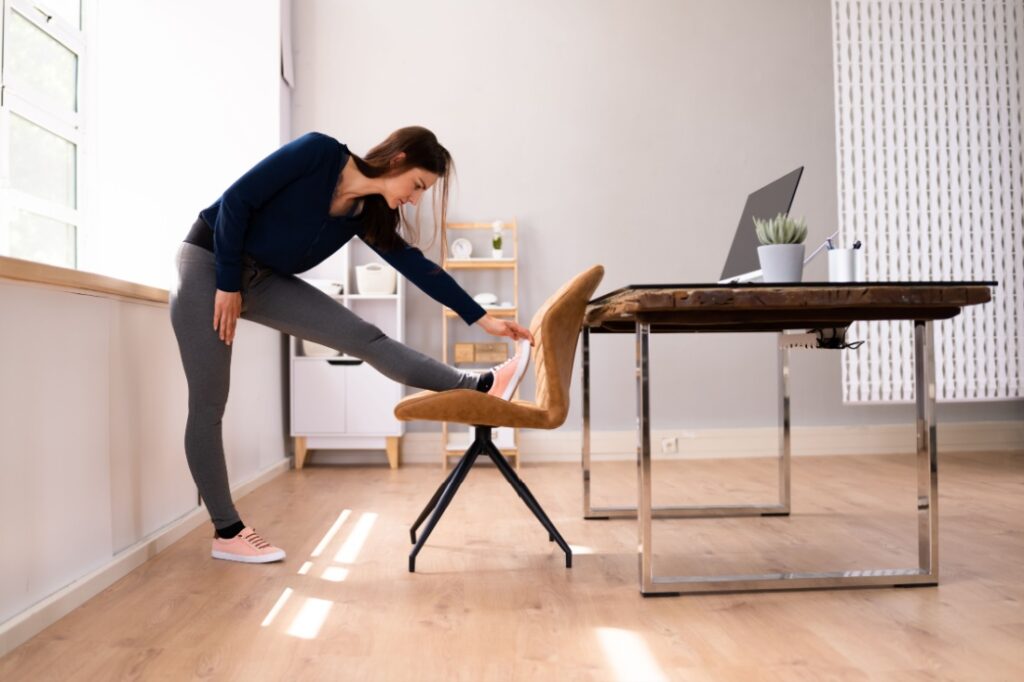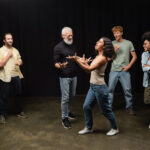Exercising and taking breaks can fall by the wayside when you’re absorbed in work. Unaware of the passing time, you might spend most of the day hunched over a computer screen, only to feel achy, stiff and lethargic later on. However, along with limbering up muscles and reducing stress, exercise combats the effects of environmental toxicity, according to physician Raj Singh, M.D. “[Exercise] works to release a lot of nitric oxide and oxidative stress, so it’s a great way to fight free radicals,” he says.
No wonder active workstations, clever setups that merge business with fitness, are soaring in popularity. These include standing desks, balance ball chairs, steppers and more.
Research shows that alternating work with exercise can change your day-to-day experience. Cognitive performance and overall health can also improve, according to a Mayo Clinic study. If done regularly, exercise can benefit your heart, increase bone strength and immunity, and improve mental health. A groundbreaking study from the University of Queensland even shows that certain types of exercise can have long-term cognitive benefits that last up to five years in older adults.
Even if you aren’t walking a mile at a standing desk, micro exercise breaks can accomplish similar results. Like little bursts of clarity, they can energize and clear your mind, helping you focus when you return to work. They may also counteract the negative effects of prolonged sitting, which include an increased risk of death from cardiovascular disease.
Note: Always practice safety and be sure to warm up thoroughly before exercising. Check with your doctor to make sure exercises are safe for you. Listen to your body’s signals and refrain from engaging sensitive areas. If a movement is uncomfortable, stop immediately and rest. Never push yourself beyond your limits.
Five-minute or less micro exercise routines
Here are some simple expert-led micro exercises and movements to weave into your day:
Warm-ups
It’s crucial to prime your muscles to prevent injury. Maricris Lapaix, a personal trainer at Centr, spotlights a couple of her favorite warm-ups:
- Seated Figure 4: “Start seated on the chair with an upright posture and with both feet planted. Cross one ankle just above the other knee, creating a 90-degree angle as best as possible. Hinge forward to feel the stretch in the hips, glutes and lower back.” Repeat on the other side.
- Standing Lat Stretch: “Start standing behind a chair with a backrest. Place your hands on the top of the backrest and walk the feet back until your arms are fully extended. With arms in extension, hinge forward and feel the stretch in the lat. Press into the palms of your hands to deepen the stretch.”
Along with Lapaix’s warmups, feel free to do your favorite warmups and stretches—and check out these seven dynamic warm-ups from the Arthritis Foundation.
Clap jacks
Lapaix’s instructions: “Start with feet hip-width apart, with arms extended directly in front of the chest. Jump both feet out while simultaneously bringing arms out to the side of the body. Maintain core tension, [relax] shoulders and jump feet back to the starting position. Modify this movement by stepping feet out to the side one at a time.”
If you have knee sensitivity, refrain from jumping and modify.
Shamanic shaking
According to Chelsea Dornan, a health coach at THE WELL, shamanic shaking is an ideal way to break free of a stress response—which usually involves tightening muscles—as it helps your body return to a relaxed state.
Dornan’s instructions: “Simply put on music, close your eyes, allow a soft bend in your knees and let your body fall loose like a rag doll. Then, shake and move in whatever way your body feels like moving.”
Open your energy centers
Dornan’s go-to yoga-based micro exercise is a heart-opening pose you can do any time of day. Dornan’s instructions are to “interlace your fingers behind your back and stretch your chest to the sky.”
While deceptively simple, the pose “increases flexibility, improves posture and enhances lung capacity while also relieving stress levels and providing an emotional release,” she says.
Seated spinal twist
Stretch your spine in a seated twist, says certified yoga instructor Linda Mangan. To do the pose, “Sit in a chair, feet flat on the floor, looking straight ahead. Lengthen through the spine, placing the left hand on [the] right knee. Gently start turning to the right. [Be] aware of lower, middle and upper back twisting as you look over your right shoulder.”
For more about spinal twists and how to safely practice them, read “How to Do Yoga Twists: The Benefits and Safety Principles” from Arhanta Yoga.
Standing half moon
Counteract poor posture from leaning over a desk with this flowing standing pose.
Mangan’s instructions: “Stand tall with legs hip-width apart. Leading with the breath, reach both arms overhead. Bring the left arm down to your left side as you reach overhead with the right. Take a few breaths as you stretch your body to the left. Inhale, straighten the body and repeat on the other side.”
Calf raises
According to Lynette Pettinicchi, Pilates instructor and founder of PR firm Mint & Honey, Co., “calf raises may help strengthen your ankles and help with stability, improve balance, assist with posture and help reduce injury risk.”
Pettinicchi’s instructions: “Stand with feet about hip distance apart, or in Pilates stance (heels together, toes apart), and lift like a ballerina onto your toes. Then lower all the way back down to the ground or hover your heels for an added challenge.”
If you have sensitivity in your feet, you may want to avoid this exercise.
Seated roll down and spine stretch forward
Engage your core muscles as you lengthen your spine with this simple movement.
Pettinicchi’s instructions: “Sit on the edge of your chair with your feet flat on the ground. Arms are straight in front of you at shoulder height. Bring your chin toward your chest and start to melt down, bone by bone, pulling your lower back toward the back of the chair while your arms reach forward until your head is in your lap. Slowly peel back up, stacking the spine and reaching the crown of the head toward the ceiling, shoulders gliding down the back until you are in the starting position.”
If you have neck sensitivity, you may want to avoid this exercise.
Inclined push-ups
Personal trainer and group fitness coach Laura Flynn Endres says that “the best push-up variation for you is the one you can do with full range, meaning you can touch your chest to whatever surface you’re pushing against. Doing push-ups with your hands elevated allows you to use a full range of motion and do more reps.”
Endres’ instructions: “Place your hands slightly wider than shoulder-width on the edge of your desk. Adjust your position so that when you bend your elbows and lower your chest to the desktop, your bustline touches the edge of the desk. Stay braced through your core and glutes, making your body a ‘moving plank’ during the push-ups. Exhale during the push and do as many reps as you can until you feel the burn or begin to lose form.”
Note: This is a strenuous exercise. You may wish to try a simpler push-up variation standing against a wall.
Chair squats
Squats may help you build strength, stability and balance.
Endres’ instructions: “Stand a few inches in front of a sturdy chair. If your chair has wheels, wedge it against a wall so it won’t move. Bend your knees, sitting your weight back into your heels and keeping your chest up, and squat low until you tap the chair or even do what I call ‘a light sit,’ meaning you perch lightly but don’t completely release into a full sit. From there, exhale as you press down through your heels to come up out of the squat and stand tall.”
Be careful not to strain yourself or do too many repetitions.
Products to improve your micro exercise workouts
Check out some of Pettinicchi’s favorite workout products:
- Apollo® Wearable: This wristband device releases “Apollo vibes”—gentle vibrations that Pettinicchi says may balance the nervous system by helping you feel calmer and more relaxed.
- Therabody Compression Boots and Theragun: “Both of these may reduce muscle fatigue, increase circulation and increase recovery time,” Pettinicchi says.
- MyFitnessPal: Pettinicchi isn’t a big calorie tracker, but she likes to be aware of what she’s eating and drinking so she doesn’t forget to take the best care of her body. This handy app will help you do just that.
- Nix Hydration Biosensor: Pettinicchi recommends this adhesive patch sensor that helps you stay aware of how much fluid and electrolytes you’re losing in real time and reminds you when to rehydrate.
Listen to your body
Develop a habit of tuning into your body and listening to its signals. Doing so will help you discover when you need a break and what areas need extra attention.
Try a mental body scan: Close your eyes and take a few slow, deep breaths through your nose into your belly. Draw your focus from the top of your head down to your toes. Notice all sensations, including discomfort, tightness and sensitivity. When you open your eyes, use these insights to avoid hurting sensitive spots and bring extra effort to others.
To give your eyes a break from strain, rub your palms together and generate some warmth. Cup your hands over your closed eyes. Let the darkness soothe and relax your eyes as you breathe slowly for a few moments. Lightly massage your forehead and facial muscles, and then remove your hands and open your eyes.
Whether you’re incorporating micro exercise routines, yoga breathing for a minute or going outside for a mindfulness walk, make a point to take regular well-being breaks. Even something as simple as pausing to tune into one of your senses can help you relieve stress and center yourself.
Photo courtesy Andrey_Popov/Shutterstock.com










